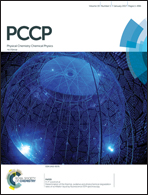The intramolecular H-bonding effect on the growth and stability of Schiff-base surface covalent organic frameworks†
Abstract
The introduction of intramolecular H-bonding by adding –OH functionalities adjacent to the Schiff base centers is considered to be a useful strategy to enhance the stability and crystallinity of bulk covalent organic frameworks (COFs). However, the influence of intramolecular H-bonding on the synthesis of surface COFs (SCOFs) have been barely explored. Herein, SCOFs based on the Schiff-base reaction between 1,3,5-tris(4-aminophenyl)benzene (TAPB) and terephthalaldehydes with symmetry or asymmetrically substituted hydroxyl functional groups are designed. In the absence of a solvent, hydroxyl substituents can be easily oxidized; thus argon protection is required to obtain high-quality SCOFs. Besides, an extended network with uniform pores can be achieved in spite of the symmetry of substituents. Both experimental results and theoretical calculations show that the influence of intramolecular hydrogen bonding on surface synthesis is not as important as that in bulk phase synthesis because the substrate itself can lead to the complanation of adsorbed molecules. The existence of intramolecular H-bonding can enhance the stability of the network in both acid and alkali environments.


 Please wait while we load your content...
Please wait while we load your content...